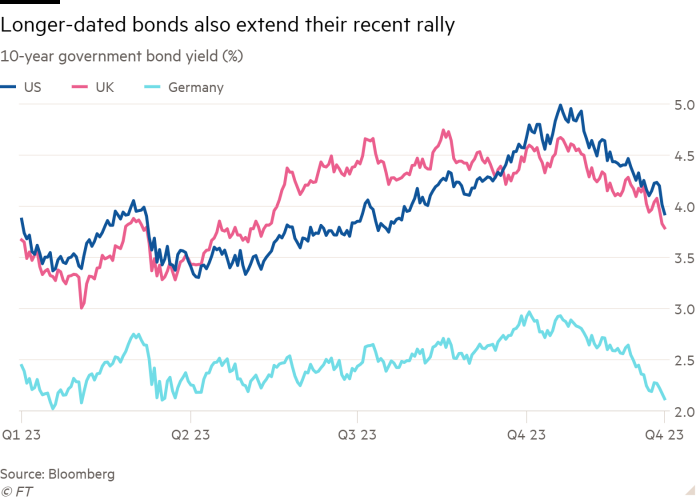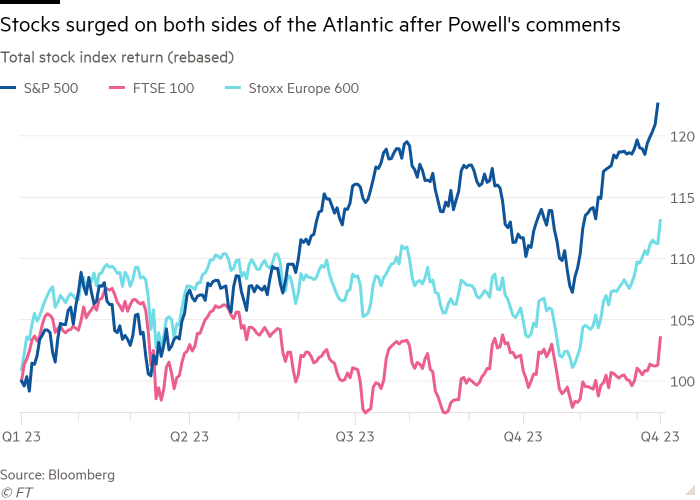Open Editor’s Digest for free
FT editor Roula Khalaf picks her favorite stories in this weekly newsletter.
Stocks and government bonds advanced on Thursday as central banks in Europe diverged from the U.S., pushing back against market forecasts of an aggressive rate cut early next year.
The S&P 500 rose 0.4 percent in New York and the Nasdaq rose 0.4 percent, leading global stock markets to rally. Treasury yields fell sharply as new projections from Federal Reserve officials pointed to a 0.75 percent cut next year, much more than investors had expected. Bond yields move inversely with prices.
“It’s a bumper early Christmas present” from the central bank, said Charles Hepworth, chief investment officer at GAM Investments.
But European shares gained after the Bank of England and European Central Bank dismissed emerging market expectations that they were ready to cut rates.
BoE Governor Andrew Bailey said there was still some way to go before inflation hit its target, while his ECB counterpart Christine Lagarde said there was “work to be done” to rein in inflation and “we must not lower our guard” against consumers. Price pressures.
However, traders were betting on European rates following the US low in 2024. Swaps markets were still bullish on six 0.25 percentage point rate cuts next year by both the Fed and the ECB and at least four rate cuts from the BoE.

Europe’s Stoxx 600 index was 0.5 percent higher, while the FTSE 100 traded 1 percent higher in London. In bond markets, the rate-sensitive two-year Treasury yield was down 0.1 percentage points at 4.38 percent, while the euro zone benchmark two-year German Bund yield was down 0.09 percentage points at 2.56 percent.
The 10-year Bund yield fell 0.03 percentage points to 2.14 percent, the lowest level since March.
“Despite the BoE and ECB trying to play back early rate cut expectations, Powell’s comments dominated Lagarde and Bailey’s,” said Mark Dowding, chief investment officer for fixed income at RBC BlueBay.
The dollar weakened 0.9 percent against a basket of peers, while gold added 0.5 percent to $2,037 a troy ounce.
Investors drew confidence from the Fed’s forecasts and Fed Chairman Jay Powell’s comments that the Fed would be “at or near the top of this tightening cycle.”
Seema Shah, chief global strategist at Prime Asset Management, said the central bank had “delivered a significant shift . . . from emphasizing long-term upside to, now, short-term upside”.

Central banks have now tightened monetary policy enough to bring inflation back to their 2 percent targets, after market expectations for interest rate cuts have been softer than expected and economic data boosted hopes in recent weeks. Markets expected the central bank to push back against the number of rate cuts for next year.
Instead, “the exact opposite happened”, said Richard McGuire, Rabobank’s head of rates strategy. “Unsurprisingly”, stocks are “loving life”, he said. “The Fed’s blindside to the market yesterday should certainly be a watershed moment for bond investors,” he added.
Sterling rose 0.8 percent to $1.2720 after the BoE said inflation “has some way to go” until it reaches its target, while risks to its inflation forecast were “tilted to the upside”.
“While the Fed will begin to discuss the possibility of a rate cut, the choice for the BoE is still between holding or hiking,” said Matthew Landon, global market strategist at JP Morgan Private Bank.
“After last night’s Fed’s firm dovish move, markets began to smell a global focus on central banks. The BoE did not follow suit.

